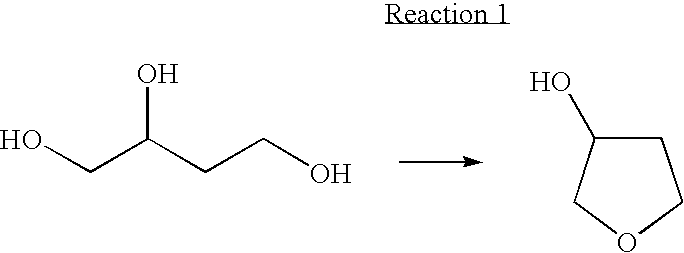Method for Preparing 3-Hydroxytetrahydrofuran Using Cyclodehydration
- Summary
- Abstract
- Description
- Claims
- Application Information
AI Technical Summary
Benefits of technology
Problems solved by technology
Method used
Image
Examples
example 1
[0025]Instead of PEG-400 and the para-toluenesulfonic acid catalyst used in Comparative Example 1, dioxane and a strong acid ion exchange resin (Amberlyst 15, H+ form) containing a sulfonic acid group were used in equal amounts. Then, the reaction was conducted using a batch type reactor under conditions of atmospheric pressure and 100° C. for 20 hours. The reaction yield was 96 mol %.
EXAMPLES 2˜3
[0026]5 g of the catalyst used in Example 1 was loaded into a completely automated continuous fixed-bed reactor made of 316 stainless steel, after which the internal temperature of the reactor was adjusted to 100° C., and then a dioxane solution containing 10 wt % of (S)-1,2,4-butanetriol (optical purity of 99.9%) was fed into the reactor at a WHSV of 2.0 h−1 to thus conduct the reaction.
[0027]The results of the preparation of (S)-3-tetrahydrofuran are shown in Table 2 below.
TABLE 2ReactionReaction Temp.Reaction Press.YieldOptical(° C.)(psig)(mol %)Purity (%)Ex. 2100Atmosph. Pressure9999.9E...
example 4
[0028]5 g of the catalyst used in Example 1 was loaded into a completely automated continuous fixed-bed reactor made of 316 stainless steel, after which the internal temperature of the reactor was adjusted to 100° C. and then a dioxane solution containing 10 wt % of (R)-1,2,4-butanetriol (optical purity of 99.0%) was fed into the reactor at a WHSV of 2.0 h−1 to thus conduct the reaction.
[0029]The results of the preparation of (R)-3-tetrahydrofuran are shown in Table 3 below.
TABLE 3ReactionReaction Temp.Reaction PressYieldOptical(° C.)(psig)(mol %)Purity (%)Ex. 4100Atmosph. Pressure9999.0
examples [UNK]
EXAMPLES 5˜6
[0030]5 g of the catalyst used in Example 1 was loaded into a completely automated continuous fixed-bed reactor made of 316 stainless steel, after which the internal temperature of the reactor was adjusted to 90° C., and then a dioxane solution containing 10 wt % of (S)-1,2,4-butanetriol (optical purity of 99.9%) was fed into the reactor at a WHSV of 2.0 h−1 to thus conduct the reaction. Under these conditions, variation in the reaction activity depending on whether N2 was added or not was observed.
[0031]The results of preparation of (S)-3-tetrahydrofuran are shown in Table 4 below.
TABLE 4ReactionAdditionReaction Press.YieldOpticalof N2(psig)(mol %)Purity (%)Ex. 50Atmosph. Pressure7099.9Ex. 66 cc / minAtmosph. Pressure8199.9
PUM
 Login to View More
Login to View More Abstract
Description
Claims
Application Information
 Login to View More
Login to View More - R&D
- Intellectual Property
- Life Sciences
- Materials
- Tech Scout
- Unparalleled Data Quality
- Higher Quality Content
- 60% Fewer Hallucinations
Browse by: Latest US Patents, China's latest patents, Technical Efficacy Thesaurus, Application Domain, Technology Topic, Popular Technical Reports.
© 2025 PatSnap. All rights reserved.Legal|Privacy policy|Modern Slavery Act Transparency Statement|Sitemap|About US| Contact US: help@patsnap.com

